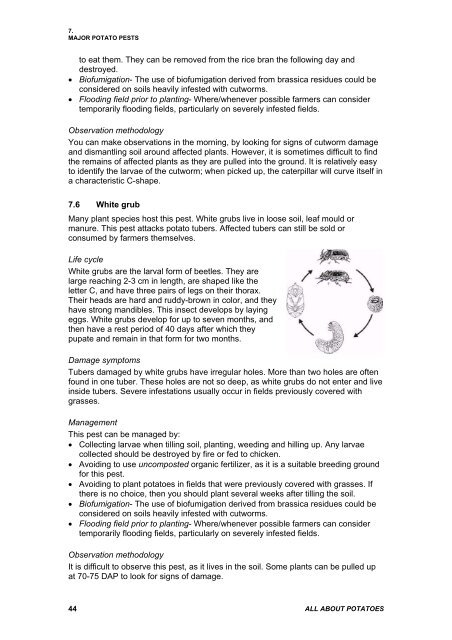All about potatoes.pdf - Vegetableipmasia.org
All about potatoes.pdf - Vegetableipmasia.org
All about potatoes.pdf - Vegetableipmasia.org
Create successful ePaper yourself
Turn your PDF publications into a flip-book with our unique Google optimized e-Paper software.
7.<br />
MAJOR POTATO PESTS<br />
to eat them. They can be removed from the rice bran the following day and<br />
destroyed.<br />
• Biofumigation- The use of biofumigation derived from brassica residues could be<br />
considered on soils heavily infested with cutworms.<br />
• Flooding field prior to planting- Where/whenever possible farmers can consider<br />
temporarily flooding fields, particularly on severely infested fields.<br />
Observation methodology<br />
You can make observations in the morning, by looking for signs of cutworm damage<br />
and dismantling soil around affected plants. However, it is sometimes difficult to find<br />
the remains of affected plants as they are pulled into the ground. It is relatively easy<br />
to identify the larvae of the cutworm; when picked up, the caterpillar will curve itself in<br />
a characteristic C-shape.<br />
7.6 White grub<br />
Many plant species host this pest. White grubs live in loose soil, leaf mould or<br />
manure. This pest attacks potato tubers. Affected tubers can still be sold or<br />
consumed by farmers themselves.<br />
Life cycle<br />
White grubs are the larval form of beetles. They are<br />
large reaching 2-3 cm in length, are shaped like the<br />
letter C, and have three pairs of legs on their thorax.<br />
Their heads are hard and ruddy-brown in color, and they<br />
have strong mandibles. This insect develops by laying<br />
eggs. White grubs develop for up to seven months, and<br />
then have a rest period of 40 days after which they<br />
pupate and remain in that form for two months.<br />
Damage symptoms<br />
Tubers damaged by white grubs have irregular holes. More than two holes are often<br />
found in one tuber. These holes are not so deep, as white grubs do not enter and live<br />
inside tubers. Severe infestations usually occur in fields previously covered with<br />
grasses.<br />
Management<br />
This pest can be managed by:<br />
• Collecting larvae when tilling soil, planting, weeding and hilling up. Any larvae<br />
collected should be destroyed by fire or fed to chicken.<br />
• Avoiding to use uncomposted <strong>org</strong>anic fertilizer, as it is a suitable breeding ground<br />
for this pest.<br />
• Avoiding to plant <strong>potatoes</strong> in fields that were previously covered with grasses. If<br />
there is no choice, then you should plant several weeks after tilling the soil.<br />
• Biofumigation- The use of biofumigation derived from brassica residues could be<br />
considered on soils heavily infested with cutworms.<br />
• Flooding field prior to planting- Where/whenever possible farmers can consider<br />
temporarily flooding fields, particularly on severely infested fields.<br />
Observation methodology<br />
It is difficult to observe this pest, as it lives in the soil. Some plants can be pulled up<br />
at 70-75 DAP to look for signs of damage.<br />
44<br />
ALL ABOUT POTATOES




![Section 4 [ PDF file, 252 KB] - The Field Alliance](https://img.yumpu.com/51387260/1/158x260/section-4-pdf-file-252-kb-the-field-alliance.jpg?quality=85)












